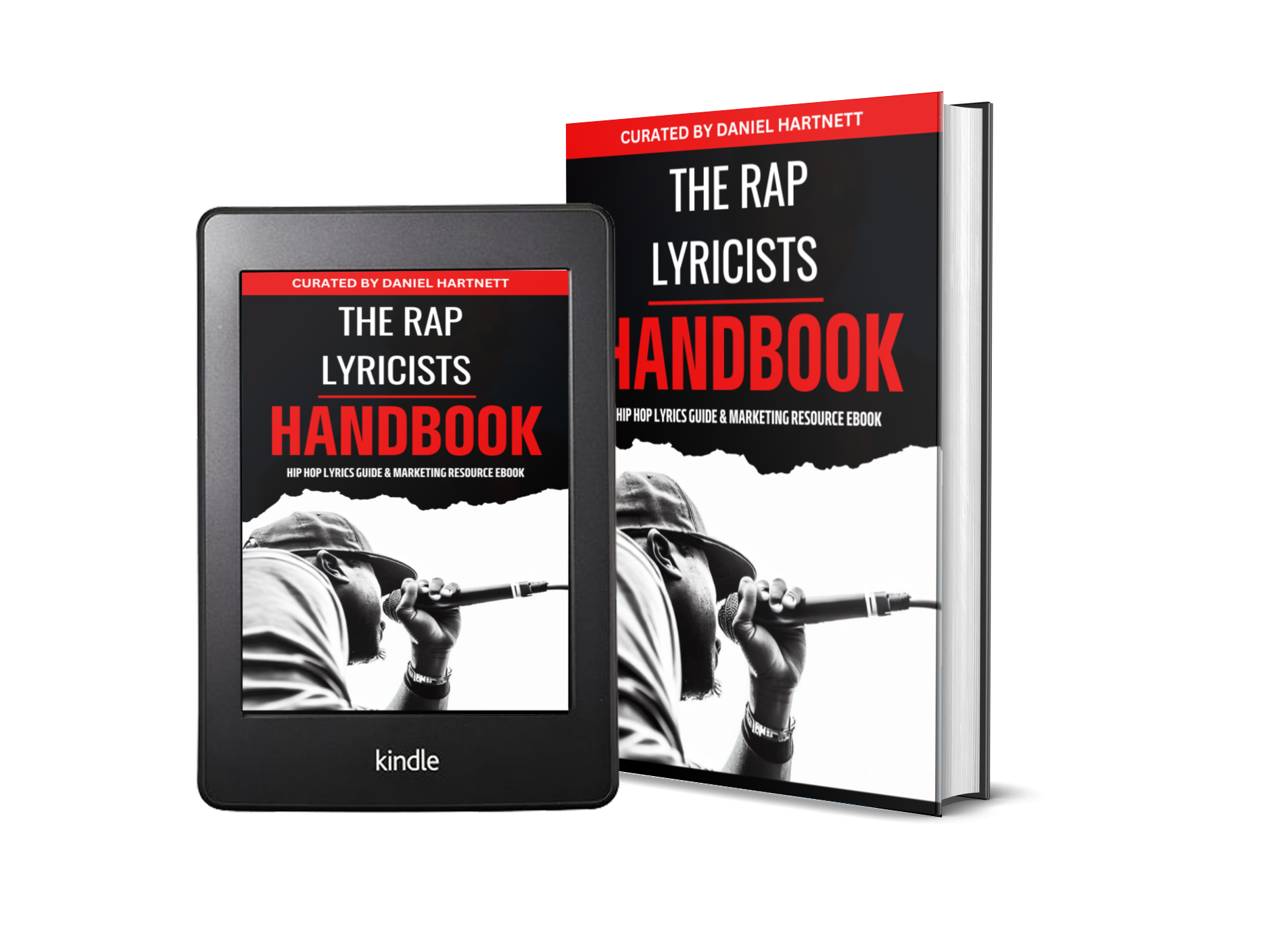!WAIT! Check Out
"The Rap Lyricists Handbook"

"The Rap Lyricists Handbook" is not just another book to skim through. It's a powerful resource designed to be your go-to companion on your journey to rap mastery.
With 250 colourful pages of curated advice, practical exercises, and proven strategies, you'll have everything you need to create hit songs that resonate with your audience.
Although some melodies may come to you in a spontaneous moment of inspiration and without much thought, there are some guidelines or tools that you can incorporate to write memorable melodies even when the inspiration is not there! If you just learn some basics of melodic construction you will see that coming up with new and catchy melodies can be much easier that you think!
1) An Overview of a Melodic Fragment

One of the most important elements in music is melody, this is because melody will provide any music piece its own identity.
As you know, there are thousands of songs that share a very similar groove or rhythm, and although the groove is a necessary element in every composition and says a lot about the song and style, just a groove it’s not enough to make a song complete. It needs a melody to be remembered and unique.
This is why you cannot register copy-rights to just a rhythm or groove, but you can register author rights to a melody, as it is distinguishable and complete.
What is a Melody?
WEBSITE RESOURCES
It is a combination of pitches (notes) with a certain rhythm, length and order.
Melody can be independent of other musical elements, I’m sure you heard sometime a melody sang “accapella” (with no other accompaniment). Acapella, is just an example of how a melody can live on its own... If you think about the old music expression of Gregorian chant, it is nothing but a single melody sung in unison or octave by a group of people.
A melody has a beginning and an end, and with this, I mean that it can’t be too long. It is helpful to think melodies as chained musical phrases that have a relationship. Just like in grammar, we use punctuation and commas; melodies also have a breathing space that separate them.
To fully understand how to create a memorable melody, let’s have a look at the components of the melody.
2) Components of a Melody

Pitch: Each note is a frequency that is known as pitch. All melodies have to have at least 2 notes to be a melody, otherwise it will just be a rhythm, right? Usually the selected notes for a melody are determined by the scale or the harmony.
Intervals: This is nothing but ALL the interval relationships created in the selected group of notes of the melody. From any note to all the others you will have seconds, thirds, fourths, etc... These intervallic relationships become very distinguishable to the ear and help to give uniqueness and structure to your melody.
Rhythm: Any rhythmic pattern can be translated to a melody by adding pitch to it. Mastering the rhythmical aspect of your melody is crucial to create continuity and interest.
Speed: The way a melody is perceived can be affected by its speed.
Time length: The maximum length of a melody can be ambiguous, but I like to think that the maximum time length for a melodic phrase should be an amount of time that allows the listener to remember it entirely.
Range: The range of a melody is the distance between the highest note in the melody and the lowest one. Usually ranges are measured in intervals, for example: “the range is one octave” or “the range is a major sixth”
Contour: Contour is formed by imagining lines between the pitches of your melody. As the melody goes up or down in pitch or range the contour is formed. The result is a visual image of how your melody evolves in range over time.
Scale: Most melodies live within the context of a Scale, it’s true that art expression should go first and theory after, but if you don’t know a lot of music theory to trespass these theoretical boundaries and be free from them with purpose, just select a scale for your melody and I guarantee construction success to you!
3) Not all Motifs are a Melody

Motifs are usually a more defined and shorter segment of notes in comparison to a melody. Although they share a lot of the musical construction principles, a melody is longer.
A motif can be thought of a cell with two or three notes that represent an idea, while a melody will carry an entire musical phrase.
Open or Close?
It’s amazing how much of a language music really is. Just like in any other language, your phrases or statements can indicate to the listener that you will say more, or, that you are closing your idea so you can open a new concept later.
Of course, this idea carries a great subjective aspect, and there is a lot of in-between space depending on who is listening.
Open Melodic Phrase
An open melodic phrase is one that ends without giving the listener the idea of conclusion. All the “components of melody” have their role here to achieve the desired purpose; examples
- Ending the melody with an ascending line or ascending interval gesture will suggest that it will continue.
- Not finishing in the root note or fundamental of the chord will also suggest the idea will continue.
- Not slowing down the rhythm at the end in your melody will provide a feeling of motion and the expectation to keep going.
Closed Melodic Phrase
On the contrary, here the listener will experience a feeling of relative conclusion. As listeners, after a little while we want to hear and feel that the melody has ended.
In music, we are always playing with the idea of tension and rest, melodically speaking, rest is achieved by giving conclusion to a melody.
- Ending the melody with a descending melodic line gives the idea of rest and conclusion.
- Ending a melody in the root note or 1st step of the scale is the most conclusive one there is. The third or fifth intervals of the chord are mostly used for open endings.
- Slow down the rhythm to anticipate the listener that a phrase is about to end. If you don’t do this, it may result in weird or strange things.
Remember there is a lot of subjective ground here! As each melody and musical context is experienced differently by the listener.
Start playing around with these ideas and you will see how useful they can be. Again, music is a language, so all the rules of communication apply to it!
4) Common Types of Melodies
Based on a Chord
Chords are great providers of structure to our melodies. Since most melodies are played on top of a chord or harmony, using those same notes is a great way to implicate the harmony with the melody! great isn’t it?
Based on an Arpeggio
In reality, arpeggios are kind of a grey zone or in-between thing between two worlds, harmony and melody. This is because they are constructed with the harmonic content (notes) of the chord, but because of its rhythm, direction and interval construction they form melodies when you play them!
They can sound amazing in some contexts! But just know that not every instrument can approach any melody based on an arpeggio easily. This is because all the skips and leaps that are formed there.
Melody is more natural when notes are next to each other. (no jumps or skips)
Depending on the structure of the arpeggio, it may result in difficulty to play sometimes. I recommend that you learn the mechanics of the instrument that you intend to interpret your melody based on the arpeggio, just to be sure it will not be an issue to the player. Midi instruments are surely laughing at what I just said, no restriction there! We are all happy for that right?
Based on a Scale
Scales will provide you with a selection of notes that will form a good foundation of your melody. Find some examples below;
- The Major or Minor Scales
- Modal Scales (Ionian, Dorian, Phrygian, Lydian, Mixolydian, Aeolian, Locrian)
- Pentatonic Scales
- Chromatic Scale
- Diminished Scale
5) Steps to Create a Better and Memorable Melody
Scale
Select a scale that you are comfortable to play in.
Sometimes selecting a scale will also affect the “feel” of your melody, or, have a tendency to sound a certain way. This is because the historical use of those particular scales. So, know what the scale does and see if it applies to what you intend.
Examples:
- Pentatonic scales can be useful to create Asian or Chinese style melodies.
- Modes are good for Jazz style melodies or medieval/Ancient melodies.
- Minor scales are good for sad moods or a melancholic feel.
Rhythm
Play the notes of the scale that you have chosen with a particular and established rhythm, do not play randomly. Create a groove or a constant rhythmic pattern.
It doesn't have to be a complicated one, some great melodies out there just use quarter notes.
Use rests! No separation or breathing space is uncomfortable to listen to.
Contour
Imagine the contour graphic of your melody, ask yourself, how will it evolve in range? Will it start low and then raise to a climax? Will it come down abruptly? Will it have a limited range, or a big one?
Select the Ending
How conclusive will be your ending? Will it resolve in the root note for a full rest, or will it be an open ending to extend the idea further on?
Maybe you can have a first part that ends open, then repeat the melody but modify the end to be more conclusive the second time.
Select the Sound
Choose what kind of instrument will carry the melody you created, or select the sound you want for it.
Also, select all the elements of expression (vibrato, staccato, etc.) these will take your melody to the next level. Now, is when you want to think about dynamics and effects that can add interest to your melodic idea.
6) Tips to Write Better Melodies
Always, select a scale that you know well.
Select a simple rhythm, keep it simple and the melody will shine better!
If you already have a chord progression, use mostly the notes of the chord that is taking place at that moment.
Emphasize chord tones in your melody by using them in strong beats.
Move mostly in steps, use some leaps but not all the time. This helps the melody to be more lyrical and singable. If you can't sing it, it's a bad indicator.
Do not use a very wide range, preferably try to stay within the octave. Leave the other octaves for repetitions or other purposes.
End your melody with the root note and slow down the rhythm close to the end to create a conclusion.
7) Summary
You can now apply these simple and effective tools to give shape to your melodies, imagination is a fantastic thing, but in reality, our brain works better when we can operate under a context or structure for those great ideas to be born, otherwise we are just lost in that immense freedom.
I believe that great melodies will arise just by playing around with these concepts and tips. Have fun creating guys.
----

Author: Leo is the founder of https://sixstringtips.com , a music website providing and sharing trust and useful information to help people easier to choose and learn to play musical instruments (guitar, violin, ukulele)
!WAIT! Check Out
"The Rap Lyricists Handbook"

"The Rap Lyricists Handbook" is not just another book to skim through. It's a powerful resource designed to be your go-to companion on your journey to rap mastery.
With 250 colourful pages of curated advice, practical exercises, and proven strategies, you'll have everything you need to create hit songs that resonate with your audience.



